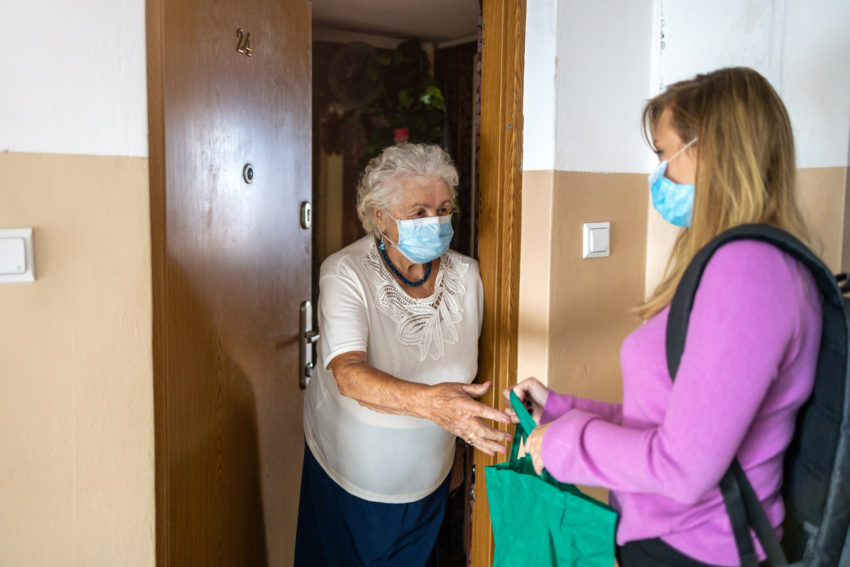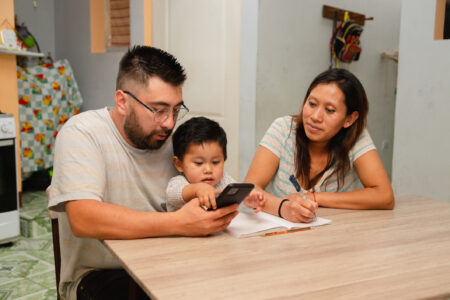
Share On Social!
As we continue the battle against COVID-19, public health authorities are urging cities to increase their contact tracing efforts.
“Contact tracing is key to slowing the spread of COVID-19 and helps protect you, your family, and your community,” according to the Center for Disease Control and Prevention.
But identifying people who have tested positive for COVID-19 and tracking their whereabouts and potential infection sources has its challenges. People may be skeptical to release information to contact tracers calling on the phone if they’re wary of scams.
And because COVID-19 disproportionately affects Latino and other minority communities, there may be a language barrier or sense of fear when discussing health information with state employees.
What can be done to face these challenges of contact tracing while still increasing the effort to stop the spread of COVID-19?
A community-based workforce may be the answer.
What is a Community-based Workforce?
A community-based workforce is made up of trained professionals that are a part of the community they serve, according to upstream healthcare provider HealthBegins.
They might be health workers, promotores de salud, social workers, non-profit staff, or other community-based leaders that share the same culture and life experiences as the people they aim to help.
With their knowledge of the community’s resources and relationship to their peers and neighbors, these community-based workers will better be able to tackle the inequities brought to light from the COVID-19 pandemic than outsourced workers would. This is especially important among Latinos, who suffer a disproportionate burden of COVID-19 cases and deaths.
When cities outsource health workers, they run the risk of not engaging with the community and widening the health and economic gaps, leading to overall less effective contact tracing.
“To increase the odds of success, states and local leaders should adopt and apply community-based workforce principles in the next phases of contact tracing and broader response and recovery efforts,” according to HealthBegins.

They recommend the following principles for cities aiming to successfully scale contact tracing through community-based workers:
- Recruit with a racial equity framework
- Invest in trusted workers, including community health workers
- Strengthen connections with psychosocial services
- Launch a community-based jobs program
- Embed job training & pipelines to local careers
- Strengthen community infrastructure and financing
What Cities are Successfully Using Community-based Workers for Contact Tracing?
Several cities have emerged as leaders for their involvement of community-based workers in their pandemic response and recovery efforts.
One of these cities is Baltimore. A majority-minority city, Baltimore was hit hard by the pandemic in the in the Latino and Black communities, according to the Baltimore City Health Department.
With the help of several foundations, the city launched a contact tracing program called the Baltimore Health Corps that embeds community-based workers in recovery.
“The Baltimore Health Corps is first-of-its-kind because it will target hiring individuals who have recently lost their jobs due to the pandemic and live in communities hardest hit by COVID-19 as community health workers, including those without previous healthcare experience,” said Baltimore Major Bernard Young at a news conference, according to the Baltimore Sun.
The program launched in June with the intention of hiring 300 people who had lost their jobs due to the pandemic. It is funded for a year, with the hopes that the community with give input through forums as it continues to grow.
“All three hundred-plus members of the Baltimore Health Corps will receive a living wage and a stipend for health insurance to serve as full-time, trusted contact tracers and care coordinators in our communities. I am grateful to this extraordinary coalition of philanthropists and operating partners who have worked tirelessly to launch this groundbreaking model in Baltimore City,” Young said.
In Nashville, similar programs are underway. Siloam, a faith-based health care organization that mainly serves immigrant communities, established a Community Health Worker program to assist with contact tracing.
“Siloam’s Community Health Worker program is a unique initiative targeting four language groups in Nashville: Arabic, Burmese, Nepali, and Spanish. Siloam-trained Community Health Workers (CHWs) serve as health ambassadors in their communities to help fellow immigrants navigate health and social service systems, address the root causes of disease, and strengthen social capital,” according to Siloam’s website.
Hannah Rai is Bhutanese refugee who helps Siloam as a community health worker. She regularly meets with refugee communities in Nashville to help them in their adjustment to living in America as well as assist with medical needs.
“We have five family members staying in the same home. It’s difficult to make social distance. So, people are still struggling with those things,” Rai told Nashville NewsChannel5. “We’re connected to the community group leaders and then we’re just working like, not only provide food and resources, we’re just trying to [walk] with them.”
San Diego (30% Latino) has also developed a community health worker program to target the Latino and immigrant communities. Partnering with San Diego State University, the San Diego County Health and Humans Services Agency aims to reach underserved communities by employing health workers from those areas.
“By hiring from our diverse communities to help serve our communities, the community health worker model, we will expand our health strategy in protecting public health in communities adversely impacted by COVID-19,” said Nick Macchione, director of the County’s Health and Human Services Agency, according to the SDSU NewsCenter.
Chicago (30% Latino) is another diverse city that has implemented a community-based workforce to conduct contact tracing. The Chicago public health department awarded a $56 million grant to involve many community organizations to assist with contact tracing in the Latino community, which has been hit hardest by the pandemic.
By involving residents, the city hopes to connect with locals at risk of infection to educate and inform them of the dangers of COVID-19.
“We know the zip codes; we are in the communities; we have really invested in the response. When we start, we can make a big impact as community partners. And we want [the tracers] to be people from the community, offer them training, and see this as career development for people in the communities we serve,” said Ted Hufstader, a director at the Esperanza Health Center in Chicago, according to the Chicago Sun Times.
What Else Can You Do?
As we continue the fight against COVID-19, we must ensure the safety of our most vulnerable communities.
That is why Salud America! at UT Health San Antonio is launching the “Juntos, We Can Stop COVID-19” digital communication campaign in English and Spanish to help Latino families take action to slow the spread of coronavirus.
The campaign features culturally relevant, bilingual fact sheets, infographics, and video role model stories—to encourage Latinos to change their public health behaviors.
See and share the #JuntosStopCovid campaign!.
By The Numbers
23.7
percent
of Latino children are living in poverty



